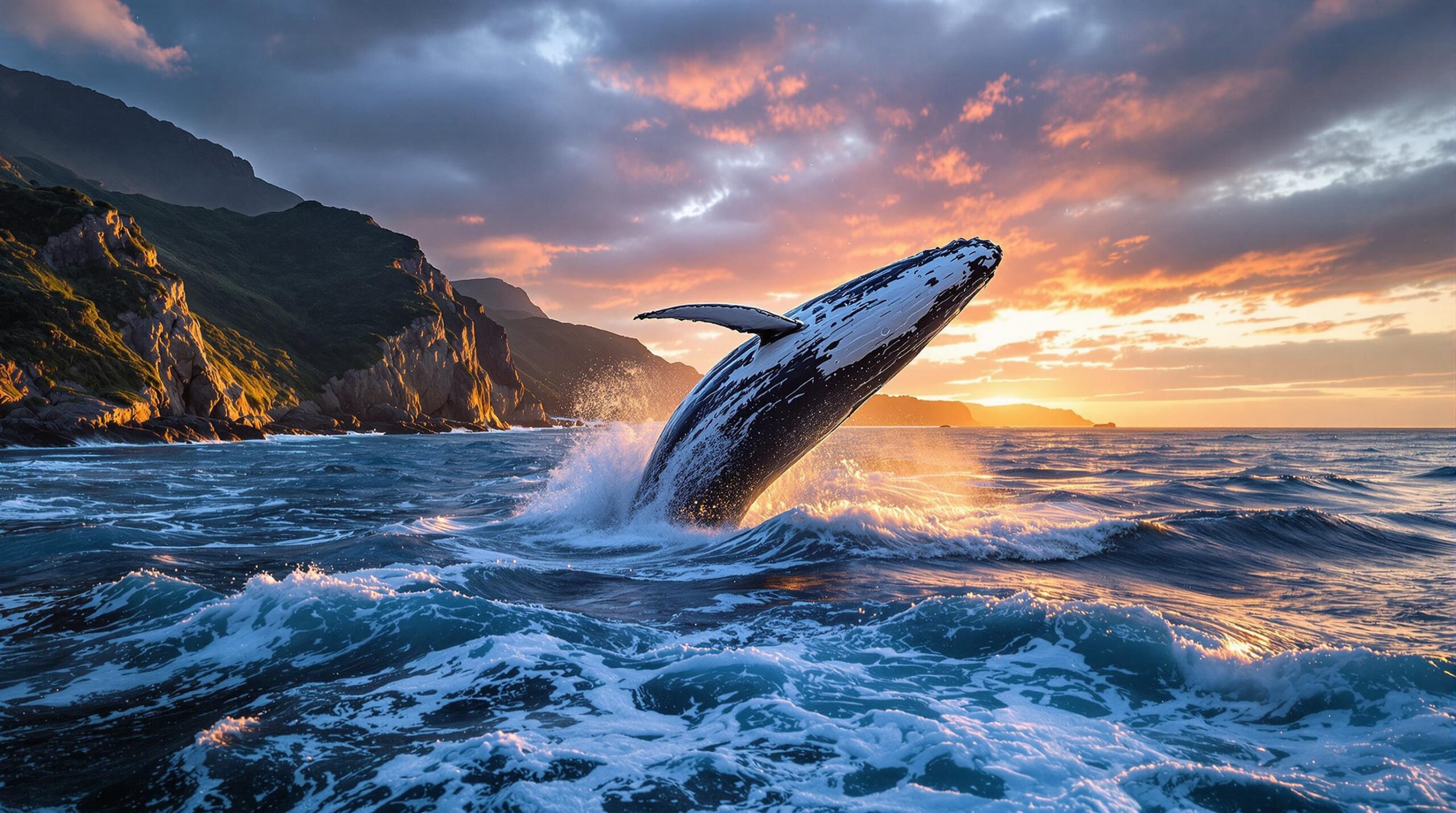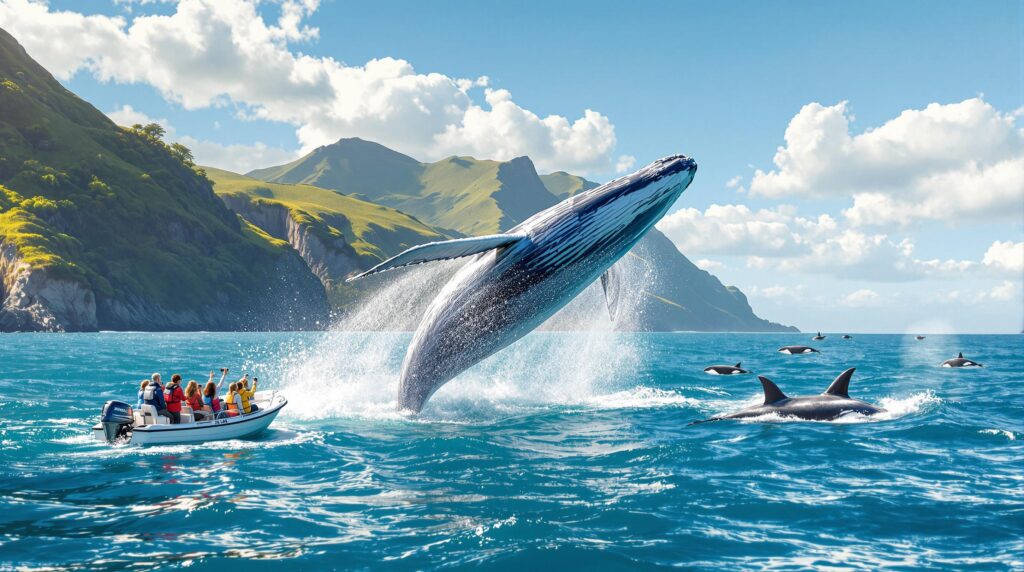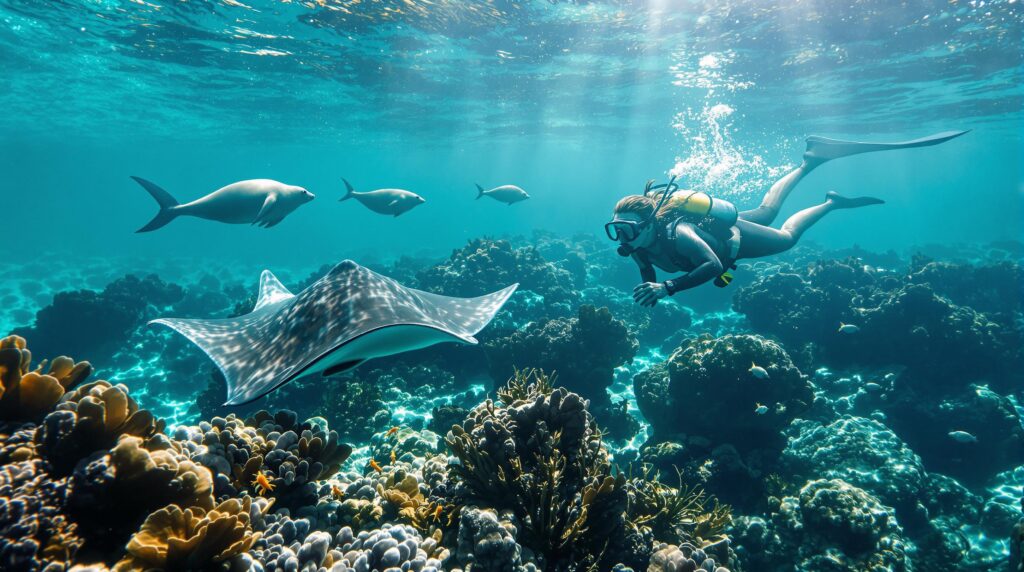As someone who has been enchanted by New Zealand’s unique blend of coastal charm and untamed nature, I feel compelled to share my discoveries with fellow travelers. Whale watching in New Zealand unfolds like a warm embrace on a crisp winter day, where the sea whispers secrets of ancient journeys and the skies tell tales of storms and calms. My wanderings, filled with memorable encounters and quiet moments of awe, have led me to some of the most captivating spots along this magical coastline. Every corner hides a story, every wave carries a promise of encounter with giants of the deep, and every tour reveals a layer of cultural heritage that touches your heart.
The energy of the ocean, the playful splash of whales, and the gentle guidance of local experts combine to create experiences that leave a lasting imprint. From intimate boat rides to thrilling encounters on the water, each glimpse of a breaching humpback or a gliding orca fills me with wonder, as if nature herself were inviting me to join a grand dance. Immerse yourself in these pages as I guide you through the scenic byways and hidden treasures of New Zealand’s whale watching adventures.
A winter wonderland: whale watching adventures in new zealand
The chill in the air is transformed by the golden light of winter, making the sea seem alive and inviting. I vividly remember the first time I set foot in Kaikoura, a small coastal town known for its vibrant marine life. The combination of calm waters and a backdrop of rugged mountains creates a scene so surreal that it almost feels like stepping into a dream. A gentle yet perceptible energy fills the atmosphere as whales communicate through rhythmic splashes and deep calls. Every moment out there on the boat feels magic, charged with the promise of a new discovery and the thrill of a close encounter.
New Zealand becomes a sanctuary for whales during winter, when the waters are warmer compared to the icy expanses further north. The whales come to find comfort and safety here, giving birth and nurturing their young. Observing these majestic creatures from relatively close quarters is an honor. I learned about the intricacies of this migration and was fortunate to book a tour with an expert whale watching guide who took me deep into the Kaikoura canyon. It is here that the ocean floor dips dramatically, luring blue whales, humpbacks, and even playful sperm whales into view.

The magic of Kaikoura lies not only in its natural beauty but also in the deep connection the locals have with the sea. I was warmly welcomed by knowledgeable Maori guides who treat each whale with reverence. Their insights into Maori mythology—where whales are considered to be wise and almost spiritual beings—added a profound layer to the experience. One such guide proudly mentioned, Whale Watch Kaikoura as being at the heart of these experiences, emphasizing that each sighting is a celebration of life and culture.
Spotting whales and orcas in kaikoura
My days in Kaikoura were filled with moments that will forever be etched in my memory. Early mornings greeted me with a calm, almost meditative silence broken only by the call of distant seabirds. As the sun rose, the shimmering waters revealed silhouettes moving gracefully below the surface. I often found myself holding my breath at the sight of a huge humpback whale executing a spectacular breach. The sheer power and gentleness of these giants were both humbling and exhilarating. I remember the excitement when a pod of orcas, also known as killer whales, surfaced; their black and white forms moving in perfect harmony. This complex display of nature’s choreography is what makes whale watching here an unmatchable adventure.
A typical day began with joining a well-prepared crew and boarding a high-speed zodiac boat, maneuvering smoothly across the waves. The captain’s deep understanding of marine life meant that we were not just spectators but participants in a delicate balance between observation and respect. I learned that responsible whale watching is about maintaining a respectful distance and ensuring that the natural behaviors of these creatures remain undisturbed. I recall a moment when the boat quietly drifted as a pod of humpbacks passed by, their calm movements reflecting a world unhurried by human worries.
Being on the water truly connects you with the elements. The salty breeze, the occasional splash, and the rhythmic lapping of the tide against the boat create a sensory tapestry. I’d often glance around and see others equally mesmerized by what was unfolding before our eyes. During one tour, I even noted a small family of whales engaging in behavior that resembled playful interaction. Such moments reaffirmed the importance of preserving these habitats for future generations to marvel at. For more tips on responsible whale watching, check out this comprehensive guide.
The diversity of species in these waters is astonishing. Among those frequently seen are the colossal humpbacks, agile blue whales, and the ever-popular sperm whales. I made a list of my top encounters to help others prepare for their journey:
- 🐳 Humpback whales – Known for their acrobatic breaches and soulful songs.
- 🐋 Blue whales – The gentle giants whose presence exudes tranquility.
- 🐬 Sperm whales – Often seen diving deep, adding an aura of mystery.
- 🐟 Orcas – Sleek, powerful, and unforgettable in appearance.
I’ve also compiled a table to share my experiences and insights on different whale species encountered in Kaikoura. The table below compares their frequency of sightings and the unique experiences they offer:
| Species | Frequency | Experience |
|---|---|---|
| 🐳 Humpback Whale | ⭐⭐⭐⭐⭐ | Whale Watch Kaikoura moments with acrobatic displays. |
| 🐋 Blue Whale | ⭐⭐⭐⭐ | Soulful glides across the vast ocean. |
| 🐬 Sperm Whale | ⭐⭐⭐ | Deep diving mysteries and serene encounters. |
| 🐟 Orca | ⭐⭐⭐⭐ | Intense presence observed by Orca Research Trust. |
While every journey in Kaikoura is unique, the essence of the experience remains in the vibrant pulse of the ocean and the shared respect for nature’s splendor. It’s not merely about the thrill of a sighting; it’s about connecting with an ecosystem that has thrived for millennia. I felt a deep gratitude during these expeditions—gratitude for the opportunity to witness something truly extraordinary, and for the responsible practices put in place by tour operators like local conservation efforts that ensure these experiences remain unspoiled for future adventurers.
Navigating new zealand’s marine life by boat
Riding the waves on a well-equipped tour boat offers an unparalleled perspective of New Zealand’s vibrant waters. My boat journeys have been filled with heart-pounding excitement and moments of profound serenity. Exploring the coastline by boat allows you to appreciate the vastness of the ocean and the intricate interplay between sea and sky. The experience is best described as both thrilling and meditative.
The marine tours here are designed by passionate teams who blend modern technology with deep local knowledge. I’ve had the pleasure of joining several expeditions, each uniquely tailored to give maximum exposure to the marine life in the region. One of my favorite experiences was with a tour hinging on the principles of respectful observation, where every move was calculated to ensure minimal disturbance to the waves of life. It was during one such tour that I came across the wonderful synergy between boat navigation and wildlife sightings.
The boat rides are typically conducted on sturdy zodiac crafts, which are agile enough to maneuver through the sometimes unpredictable coastal waters. The crew often shares fascinating tidbits about the local marine ecosystem, enriched by years of experience and a genuine love for the sea. One memorable morning, the calmness of the water was suddenly decorated by the emergence of a pod of whales leaping energetically; their silhouettes etched against a dawn-lit horizon. It meant more than a typical sighting—it was an interaction with nature at its purest, a moment you wish could last forever.
During these tours, safety and conservation are held in the highest regard. Modern boats are equipped with the latest navigation and communication systems, ensuring that each journey is as secure as it is spectacular. I recall a tour with Whale & Dolphin Watch Kaikoura where the crew explained in detail the protocol for whale watching, emphasizing the importance of maintaining a respectful distance. This experience reinforced my belief that true adventure comes with a responsibility toward the environment.
The panoramic views from the boat are another aspect that transforms the journey. As you glide over the waves, the coastline reveals hidden coves and cliff formations that have their own stories to tell. The interplay of light and shadow on the water creates an ever-changing canvas that captivates your senses. I often found myself overwhelmed by the mesmerizing play of colors during sunset, with hues of orange and purple reflecting off the water while the whales danced in the fading light.
Throughout my expeditions, I encountered a wide array of marine life, each adding its flavor to the rich tapestry of the ocean. For families and solo travelers alike, these journeys offer an intimate glimpse into the lives of creatures that travel vast distances and embody the spirit of freedom. I fondly recall the calm while observing a playful display of dolphins—an encounter that left an indelible mark on my soul. For fellow enthusiasts looking for similar adventures, I recommend checking out Kaikoura Whale Watching Tours to explore these wonders.
My travels have been blessed with opportunities to witness both common and rare marine wonders. Some days, the sea gifts you moments of solitude with just the gentle guidance of the boat’s course, and other days, it surprises you with an exuberance that reminds you to live in the moment. An encounter that I cherish is when a playful pod of dolphins circled our boat; it was like watching a ballet performance set to the rhythm of the waves. The crew’s expertise, combined with the advanced technology on board, made it possible to capture these fleeting moments with clarity and respect.
Unique encounters on the water
There is a distinct magic in embarking on these maritime adventures, where every ripple in the water might herald a new and unforgettable sighting. The boat tours offer not only excitement but also a deep sense of connection with the ocean. Navigating through the channels, I discovered quiet bays and underwater canyons teeming with life. It’s a setting that reminds you of the underlying balance maintained by nature. Every expedition is a lesson in patience and wonder—a gentle reminder that miracles often exist in the spaces between tides and horizons.
Many operators, such as Kaikoura Ocean Adventures and Dolphin Encounter, build their tours around eco-friendly practices. Their knowledge of tidal patterns and marine behavior helps create an environment where wildlife is given space to flourish undisturbed. I remember sharing a sunny afternoon with a group of enthusiastic locals and international travelers who were all united by the same passion for the deep blue. As we drifted near a rocky outcrop, the water around us glistened with the activity of small fish and schools of glittering plankton—a living mosaic that perfectly encapsulated the vibrancy of life beneath the surface.
Beyond the thrill of sightings, the boat tours also offer educational insights into the delicate balance of marine ecosystems. Crew members often discuss the importance of conservation and responsible tourism, sharing how each small action contributes to the larger picture of environmental protection. Their expertise is invaluable, as they point out nuances that would otherwise go unnoticed—a subtle change in water temperature, the distant call of a migrating whale, or the synchronized movement of a school of fish. These small details, observed over hours on the water, make you appreciate the sheer complexity as well as the fragility of the ocean’s rhythms.
Encounters with marine life have a way of inspiring deeper reflections on our place within nature. While some moments are thrilling, others are imbued with a contemplative quality—a silent acknowledgment of life’s many wonders. I always felt a serene camaraderie with my fellow travelers during these journeys. The shared awe and quiet conversations aboard were as memorable as the sightings themselves. To add to the sense of community and shared passion, tour operators sometimes provide refreshments, turning the journey into a social affair that enriches the overall experience. For more detailed reviews of these memorable journeys, visit detailed whale watching reports from seasoned marine enthusiasts.
Cultural connections and conservation efforts
The relationship between local communities and the ocean in New Zealand is profound and steeped in tradition. The Maori people hold whales in a place of deep respect, often considering them as ancestral spirits and protectors. I had the privilege of listening to elders explain how every whale that graces these waters is woven into the fabric of their history. Their tales are not just stories, but living traditions that encourage respectful observation and sustainable tourism practices.
Participating in a tour led by Maori guides was a transformative experience. The guides not only described the natural behavior of the whales but also explained the spiritual significance behind the sightings. Their teachings emphasize that the ocean is not merely a resource, but a revered entity with the power to teach, nurture, and inspire. These encounters further deepened my understanding of why conservation is treated with such care in New Zealand.
I recall one particular evening when the sea, bathed in the orange glow of dusk, appeared to come alive with whispered stories of the past. The guide spoke of how whales were believed to be the guardians of the deep, a notion that resonated with every ripple on the surface. Their narratives intertwined with scientific research, promoting a message of coexistence. This balance between tradition and modern conservation is actively supported by organizations such as Orca Research Trust, whose efforts help protect these majestic creatures.
These cultural insights blend beautifully with modern conservation efforts. There is a growing movement towards sustainable tourism, where every tour is designed to minimize environmental impact. Operators like Auckland Whale & Dolphin Safari and Whale & Dolphin Watch Kaikoura not only prioritize the comfort and safety of their guests but also ensure that their practices have a positive influence on marine life. The emphasis on eco-friendly initiatives, including maintaining safe distances and reducing noise pollution, is at the heart of every expedition.
Learning about the meticulous conservation strategies in place has been both inspiring and reassuring. Professional organizations and local communities work hand in hand to monitor whale populations and ensure the long-term health of the marine ecosystem. For example, local agencies actively monitor the reproduction and migration patterns of whales, offering insights that guide both research and recreational activities. My conversations with these experts often revealed that each sighting contributes to a broader understanding of marine biology, enriching conservation strategies with real-time data. Initiatives like these are a testament to New Zealand’s commitment to safeguarding its natural heritage.
Not only do these tours celebrate the beauty of the natural world, but they also serve a larger purpose in raising awareness. Seeing the ocean up close, with its dynamic interplay of life and landscape, fosters stewardship among travelers. The experience goes beyond the thrill of an encounter—it inspires individuals to become ambassadors for environmental protection. Reading about conservation efforts reminded me of the importance of supporting sustainable practices. I found additional resources at responsible whale watching information, which delve into the best practices for minimizing human impact on marine habitats.
The connection between cultural heritage and conservation in New Zealand adds a rich layer of meaning to every whale watching tour. It isn’t just about spotting a breaching whale—it’s about understanding and valuing the traditions that have helped preserve these creatures for generations. Alongside long-standing customs, modern technology now plays a role in tracking whale movements and ensuring that tours remain non-intrusive. This blend of age-old wisdom and contemporary methods creates an enriching experience that leaves you with both knowledge and wonder.
During one of my memorable excursions, I had a heart-to-heart conversation with a local guide about the changes they’ve witnessed over the decades. The ocean has always been a source of both mystery and meaning. By sharing stories and scientific insights, they helped me appreciate the significance of every sighting. The collaborative efforts of local communities, researchers, and tour operators continue to fortify the delicate balance between human activity and nature.
Maori traditions and modern conservation
That day on the water expanded my perspective on the true value of natural encounters. Conversations with Maori guides often illuminated unique customs that shape the way local communities interact with the ocean. They shared legends of whales as divine entities, messenger creatures that embody wisdom and grace. The emotional depth of these stories was palpable, making every wave and ripple seem like a living chapter of history.
In my experience, tours that incorporate traditional Maori knowledge and conservation practices foster a unique sense of respect for the sea. Companies such as EcoCentre Whangarei and Dolphin Discoveries stand at the forefront of these initiatives. They ensure that every observation is conducted ethically, allowing visitors to enjoy the majestic displays while contributing to vital research and preservation efforts. Spending time with these communities taught me that every whale sighting is interwoven with cultural heritage and environmental responsibility.
The guiding principles shared by local experts are simple yet profound: treat nature with reverence and always be mindful of its fragility. It was not unusual to be reminded that we are merely guests in this extraordinary ecosystem. These reflections encourage a deeper commitment to sustainable travel. I found inspiration in the stories and a renewed sense of duty to protect these ocean treasures. The combination of traditional wisdom and scientific insight reassures me that each tour not only entertains but also educates and empowers visitors to become guardians of nature.
For those looking to dive deeper into the cultural aspects of whale watching, resources like cultural conservation insights offer detailed perspectives on the history and ongoing efforts to maintain this balance. This union of tradition and conservation continues to shape every experience, making it not only a visual feast but also a soulful journey into the heart of New Zealand’s maritime legacy.
Planning your trip: tips, tours, and recommendations
Organizing a whale watching adventure in New Zealand requires careful preparation, and my personal experiences have taught me the importance of planning ahead. The seasons, the weather, and even the choice of tour operator can greatly shape your encounter. Having explored numerous coastal routes and met several seasoned guides, I’ve gathered insights that can help you maximize your experience and ensure each moment holds the promise of discovery.
- 📝 Whale Watch Kaikoura – Ideal for first-time explorers eager to experience the magic of Kaikoura’s ocean.
- 📸 Auckland Whale & Dolphin Safari – Perfect for families and those wanting detailed commentary on marine life.
- 🎟️ Whale Island Cruises – A stellar choice for intimate tours complemented by breathtaking seascapes.
- 🚤 Black Cat Cruises – Offers specialized tours for enthusiasts seeking exclusive and dynamic experiences.
Booking the right tour can make all the difference. I discovered that selecting a tour operator with a strong environmental ethos and local expertise, such as Kaikoura Whale Watching Tours, ensures not just a memorable experience but also contributes to the protection of marine life. Knowing that my adventure was part of a larger conservation effort gave me a sense of shared responsibility and joy.
The process typically starts with researching the season. In New Zealand, whale watching is best between December and April, when the water is inviting and the chance of sightings is high. I always advise travelers to check weather conditions and secure reservations well in advance. Several websites, including local travel guides, offer real-time updates and detailed itineraries that can help tailor your trip.
Safety is paramount. Tour operators provide comprehensive briefings on what to expect and how best to enjoy the experience without disturbing the wildlife. I was impressed by how the guides emphasized maintaining respectful distances and staying quiet during close encounters. Embracing this respectful approach not only enhances your own experience but also supports initiatives aimed at protecting these magnificent creatures.
When it comes to accommodations, there is a wealth of choices along New Zealand’s coast. Whether you opt for a cozy bed-and-breakfast or a modern hotel with panoramic views, the key is to choose a place that reflects the local charm and offers easy access to whale watching tours. I once stayed at a delightful seaside lodge that provided breathtaking views of the ocean, making each morning feel like waking up to an endless canvas of blue.
Here’s a rundown of what to consider when planning your whale watching trip:
- 🌟 Tour schedule – Verify timings and book a tour that aligns with local peak sighting periods.
- 🌟 Weather forecast – Keep an eye on local weather and sea conditions for a safer journey.
- 🌟 Local accommodations – Find lodgings that combine comfort with convenience.
- 🌟 Environmental guidelines – Respect the local practices by choosing eco-friendly operators.
For those seeking a detailed comparison of various tour options, I created a table that outlines key aspects such as tour name, price range, and overall rating. This comparison can serve as a quick reference as you decide which operator best suits your expectations:
| Tour Name | Price Range | Rating |
|---|---|---|
| 🌟 Whale Watch Kaikoura | $150 – $250 | ⭐⭐⭐⭐⭐ |
| 🌟 Auckland Whale & Dolphin Safari | $120 – $200 | ⭐⭐⭐⭐ |
| 🌟 Whale Island Cruises | $100 – $180 | ⭐⭐⭐⭐⭐ |
| 🌟 Black Cat Cruises | $130 – $220 | ⭐⭐⭐⭐ |
Each tour offers unique opportunities and experiences. For budget-friendly tips on exploring New Zealand by campervan, I recommend this detailed itinerary, which provides insights into traveling with comfort and style. Meanwhile, resources like comprehensive whale watching tips can help you prepare for the unexpected delights awaiting you on the water.
Exploring New Zealand’s abundant marine life is more than a recreational activity; it’s a gateway to understanding nature’s intricate rhythms. The careful planning, coupled with immersive experiences, creates a journey that transcends the ordinary and touches your very soul. Taking the plunge into such adventures leaves you enriched with memories and a commitment to preserving these natural wonders for generations to follow.
FAQ
Q: What is the best time to go whale watching in New Zealand?
A: Winter months, from December to April, provide the best opportunities as the waters warm up and whale activity is at its peak.
Q: Are the tours in Kaikoura family-friendly?
A: Absolutely. Many tours, including Whale Watch Kaikoura and Auckland Whale & Dolphin Safari, are designed to be friendly and educational for visitors of all ages.
Q: How can I ensure my whale watching experience is eco-friendly?
A: Choose operators with strong conservation practices, such as Whale & Dolphin Watch Kaikoura and Kaikoura Ocean Adventures, follow safety guidelines, and maintain a respectful distance from the wildlife.
Q: What types of whales and marine life might I see?
A: Common sightings include humpback whales, blue whales, sperm whales, and orcas, among others. Each species offers its own unique spectacle during your tour.
Q: Where can I find more information on local tours and accommodations?
A: Resources like New Zealand Whale Watching and Kaikoura Whale Watching Tours offer excellent guides on planning your adventure.
Hi, I’m Mark, a 38-year-old travel writer who traded his backpack for a peaceful life in New Zealand. After exploring dozens of countries, I’ve found my home among native bush, coastal walks, and the welcoming spirit of Kiwis. I now write about hidden gems, soulful places to stay, and local tips to help travelers experience the real New Zealand – slow, beautiful, and full of meaning.



